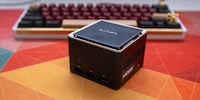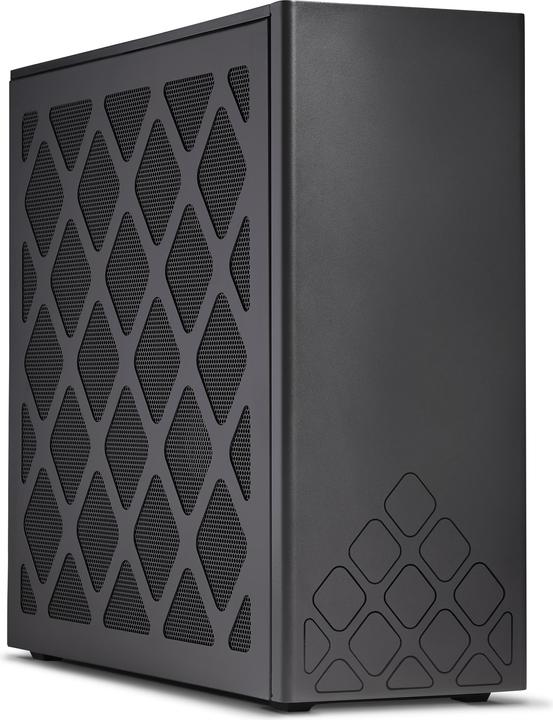

A wild Raptor NUC with an even wilder price tag
With its Extreme Raptor Canyon, Intel delivers the largest NUC to date – in terms of size and performance. I ask myself the same question as I do with all crazy NUCs: who’s going to buy this?
With the NUC 13 Extreme Raptor Canyon, Intel has crossed the line from tiny to small form factor PCs. The predator has packed in decent performance, but costs a pretty penny.

Design specs and ports
At 33.7 × 12.9 × 25 centimetres, this NUC is the largest of its kind that I’ve ever come across. The sides and top are dominated by mesh ventilation, a lattice broken up by rounded rhombuses.
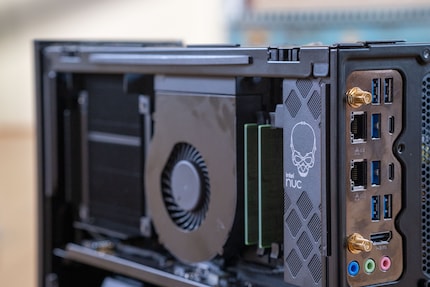
Source: Kevin Hofer
The included power supply provides 750 watts. My test sample comes with a 24-core Intel Core i9-13900K CPU. I need to provide the SSD, RAM and graphics card myself. SO-DIMM DDR5 modules up to 64 gigabytes (GB) are supported for the working memory. Three M.2 ports with PCI Gen4 standard are available for SSDs.
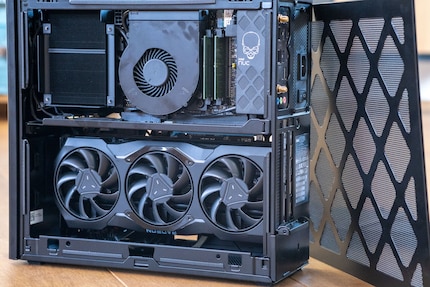
Source: Kevin Hofer
In terms of connectivity options, the Extreme Raptor offers eleven ports for USB devices, among others. Here’s an overview of the ports:
- 2x Thunderbolt 4 (USB Type C)
- 1x HDMI 2.1.
- 6x USB 3.2 Gen2 Type A at the back
- 2x USB 3.2 Gen1 Type A at the front
- 1x USB Gen 2x2 Type C at the front
- 2x 3.5 mm headset jacks
- 1x 2.5 Gigabit LAN
- 1x 10 Gigabit LAN
- Wi-Fi 6E and Bluetooth 5.2
I equip my test sample with 32 GB of RAM, a 1 TB SSD and a Radeon 7900 XTX. I choose this graphics card as none of my other current test cards will fit the Extreme Raptor Canyon. Any GPU can be a maximum of 31.3 centimetres long and three slots thick. You can find a list of compatible hardware recommended by Intel here.
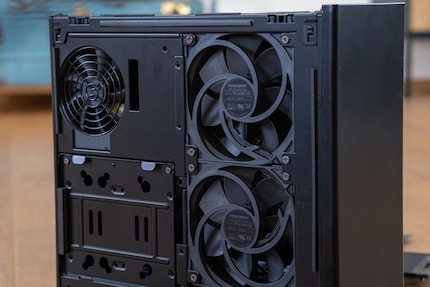
Source: Kevin Hofer
Temperature, volume and power consumption
It’s amazing how cool the system stays even under load. The CPU doesn’t reach its thermal limit, even in the stress test. That’s because it’s limited to only 125 watts. In extreme scenarios, it’s still allowed to call up 150 watts. Out of all 500 watts of system power, 347 go to the GPU.
When browsing or doing office work, the Extreme Canyon is barely noticeable at 35.5 decibels (dB). When gaming, the device is already clearly audible at 44 dB. In a stress test using AIDA64 and FurMark, the fans roar at 51 dB. Here are all the measurements at a glance:
The NUC’s effective ventilation is obvious when using a thermal imaging camera. Heat dissipates on the left, while fresh air is added on the right side. So think carefully about how you place the NUC, allowing it to draw enough fresh air. If you’re cold in the winter, just point the left side towards yourself and you’ve got a nice space heater. In summer, just turn away the NUC and feel a fresh breeze.
Left: the hot back – right: a cool front
Performance in productivity applications
The i9-13900K delivers decent performance in the Extreme Raptor Canyon. However, its performance is obviously limited in the NUC. In both Cinebench R23 and the Blender benchmark, the processor lags behind an unlimited 13900K by 23 and 22 per cent, respectively. Compared to the previous NUC and an NUC 12 Enthusiast Kit, however, the performance leap is enormous.
What the benchmarks test
Cinebench R23 tests how a CPU performs when rendering 3D models. The benchmark creates scores for single- and multi-core performance from these calculations.
As of version 3.3, Blender Benchmark renders three scenes in a 3D graphics suite and calculates three scores from them. I add these together to get a final score.
The UL Procyon Photo Editing Benchmark and Video Editing Benchmark simulate various workloads in the Adobe Creative Suite. Finally, the benchmark calculates a score.
Performance in games
The following charts show the arithmetic mean of frames per second (fps) when comparing the NUC to a desktop system across all three benchmarks. Clicking through the gallery, you’ll see the results from individual games. For a better comparison, I’ve also added the results of a Benchtable system with an i9-13900K and RX 7900 XTX.
The games show that FPS remains the same whether on an open test bench with an unlimited i9-13900K and RX 7900 XTX or an NUC with the same components. Any minor differences are within the usual variance. Thus, you can use this NUC perfectly as a small gaming PC with a corresponding graphics card.
How I test games
The system runs on Windows 11 in version 22H2 (22621.1413). Aside from activating XMP in the BIOS, I leave everything on default. Resizable BAR was enabled. For the graphics card, I use version 23.3.2 WHQL of the driver. I run each benchmark three times and take the best result. For the games, I use the highest possible presets. Otherwise, I leave everything at default except for the resolution. I leave DLSS, FSR and Xess deactivated.
Verdict: cool, but too expensive
In terms of performance, I can’t find fault with the NUC 13 Extreme Raptor Canyon. The i9-13900K in the NUC, limited to 125 watts, is separated by a maximum of 23 per cent from the same, unrestricted desktop processor when tested. In return, it stays pleasantly cool in the small system. I don’t notice any difference when gaming. Thus, it could be especially interesting for gamers – there’s just that dang price.
At just over 1400 francs/euros (as of March 28, 2023), the NUC Extreme Raptor Canyon is expensive. Then there’s added costs for the SSD, RAM and graphics card – in my case doubling the bill.
I come to the same conclusion with the NUC 13 Extreme Raptor Canyon as I did with the 11 and 12 models. I can’t see a target audience. The predecessors could still score some points with their size. However, the new one is just as big as certain mini-ITX cases. A Mini-ITX system offers you free choice in all components. With the Raptor, you can only choose RAM, SSD and the graphics card. In addition, it’s air-cooled – you can usually install an all-in-one water cooling system in DIY PCs. This way, an expensive CPU doesn’t have to be limited in performance, as is the case with the NUC. I’d prefer a mini-ITX system over the truncated Raptor in any case.
From big data to big brother, Cyborgs to Sci-Fi. All aspects of technology and society fascinate me.

